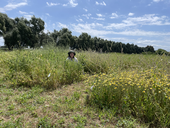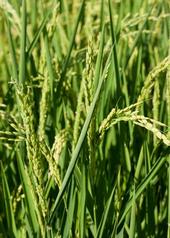- Author: Justin Valliere
- Posted by: Sam Romano

One of the first steps in ecological restoration is often controlling invasive weeds, which can be a major barrier to native plant establishment. But what happens after restoration is complete? At most sites, weed pressure is an ongoing challenge that land managers must grapple with to maintain the diversity, structure, and functioning of native plant communities.
The Invasive Weed & Restoration Ecology Lab at UC Davis is currently exploring the use of “competitive planting” as a method for weed suppression in restored grassland communities. As part of a USDA-funded project, we are evaluating what seed mixes can best facilitate the establishment of native perennial bunchgrasses while also preventing reinvasion of...
- Posted by: Gale Perez

Sterile Pollen Technique Shows Promise for Palmer Amaranth Weed Control
Newly published research provides a novel and sustainable weed-management strategy
WESTMINSTER, Colorado – 22 May2024 – Recently published research in the journal Weed Science shows that a sterilization technique commonly used to control insect pests can be modified to control weeds that require pollination to reproduce. More specifically, the researchers determined that employing a sterile pollen technique (SPT) could effectively disrupt Palmer amaranth (Amaranthus palmeri S.) reproduction.
Palmer amaranth remains among the most detrimental weeds in North American agriculture,...
- Posted by: Gale Perez

From the eOrganic and Performance and Economics of Electric Weed Control in Organic Perennial Crops Project:
Electric Weeding Research Updates
(Click HERE to see the presentations)
- Electric Weed Control in Orchards • Tong Zhen, Ph.D. student (Hanson Lab) at UC Davis
- Crop Safety and Weed Control in Organic Highbush Blueberries Using Electric Weeding • Luisa Baccin, Ph.D. student (Moretti Lab) at Oregon State University
- Posted by: Gale Perez

Congratulations to UC Davis weed science graduate student Erika Escalona (Fennimore Lab) for winning 1st place in the student poster presentation category at the 2024 California Plant and Soil Conference on Feb. 6-7, 2024 in Fresno, CA.
* * * *
Evaluating Bacterial Diversity in Steam Fumigation Treatments in the Salinas Valley's Lettuce Fields
Erika Escalona, University of California, Davis; Steve Fennimore, UC Cooperative Extension, Weed Specialist, Salinas; Department of Plant Sciences, University of California, Davis; J.S. Rachuy, Department of Plant Sciences, UC Davis; Cristina Lazcano, Department of Land, Air and...
- Author: Whitney B Brim-Deforest
- Author: Roberta Firoved
- Posted by: Gale Perez

California rice growers will have a new herbicide available this year: Cliffhanger™, manufactured by Gowan Company. The active ingredient is benzobicyclon, which is the same as one of the two active ingredients in the currently registered herbicide, Butte®. Cliffhanger™ is a soluble liquid formulation (SC) which can be applied by ground-rig or airplane, including as a direct-stream application into the water. In contrast, Butte® is a granular formulation, as a pre-formulated mixture of benzobicyclon and halosulfuron. To use either product, applicators must attend a training and be certified.
Dates for the training are posted on the California Rice Commission calendar


